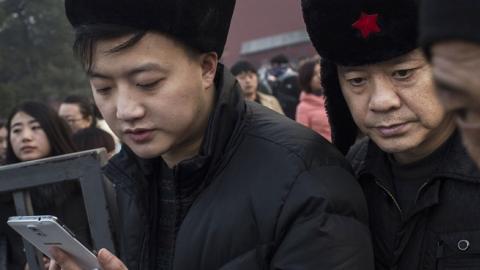At a convention in Barcelona over the weekend, Samsung unveiled its much anticipated Galaxy S6 smartphone, due for release in around 20 countries, including Australia, in April.
I will leave it to those much more au fait with the latest in all things smartphone to offer an opinion on how the S6 will go. But in China, the South Korean company has much riding on it. This article is not so much about Samsung as it is on what it takes for international brands to win in China. But we can nevertheless learn something from the varying fortunes of Apple and Samsung in recent times.
So what is the recent performance of both brands in what became the world’s largest smartphone market in 2012, and one that is behind one quarter of all smartphone sales each year?
In 2012-13, articles were all about how Samsung was eating Apple’s lunch in China. Samsung moved earlier into China and established a superior network of retail outlets and distribution and network agreements with local players. By the middle of 2013, Samsung had three times more retail outlets than its American rival in China. The Korean company had about one-fifth of the Chinese smartphone market, while Apple’s was one-tenth and falling (in percentage terms, although growing in absolute numbers.) Samsung’s advertising spend overwhelmed that of Apple’s.
It was not just about presence. The two brands pursued different strategies in China. While Apple released only one new smartphone each year positioned at the very premium end of the market, Samsung has a more diversified approach. The Korean brand brought out multiple phones each year at all position and price points in the market. Specific phones were loaded with specific features for particular markets. For example, some Samsung models were designed specifically to operate local apps such as POCO.cn, then the most popular photo sharing site in China.
So while Apple still represented California cool -- something that never lost its sheen despite brand America suffering a slight downgrade of late -- Samsung was praised for understanding its market. iPhones might have been the coolest thing on the market but cool was not the primary criteria for every consumer. While Apple appeared inflexible and even arrogant -- with its limited premium offering too expensive for many consumers -- Samsung was seen as flexible, agile and responsive.
Fast forward to 2014-15 and the Korean brand is no longer gloating. Some numbers and surveys tell the story. One study suggests that over 42 per cent of prospective smartphone buyers want an iPhone compared to less than 32 per cent for Samsung. Another survey asking the same question has the same figure for Apple and a 38 per cent figure for Samsung -- better for the latter but still significantly below its major rival.
Tellingly, Apple hangs on to more than three-quarters of its users from year to year despite the intense bidding war going on between brands through offering more and more attractive smartphone plans to switch each year. In contrast, Samsung keeps only about one-third of its users from one year to the next. It is no surprise that in 2014, Apple was able to take three times as many Samsung customers (33 per cent) as Samsung was taking from Apple (11 per cent).
The bottom line is that Apple’s sales in China doubled in 2014 from the year before, while Samsung’s growth could well be close to single digits. Add to the fact that Apple makes far more from each phone sold in China than Samsung because of the former’s premium product positioning and pricing and it becomes clear that Apple is one large multinational doing well in China, even as it has been targeted by the country’s arbitrarily deployed anti-trust laws and agencies.
What are the lessons of Samsung’s struggle and Apple’s successes in China? The first goes back to basic branding principles that can be found in any textbook for a Marketing 101 class. Premium brands are extremely difficult to build and sustain. Yet, there are good reasons why companies covet them in their product stables.
For one, a premium brand is more price inelastic, meaning that one can protect price (and therefore maximise profit margin) in any market. In a Chinese market where the absolute numbers of those able to afford a premium smartphone are growing rapidly (even if the rise of a middle-class in proportionate terms is often over-stated,) maintaining premium standing offers Apple a pricing power that Samsung does not have. Indeed, the evidence in China is that Samsung will be pricing its S6 flagship product based on the iPhone price, not the other way around.
In contrast, Samsung’s approach of flooding the market at all price-points might have temporarily increased its sales but the Korean giant may have damaged its premium branding status at the same time. The problem for Samsung is that when it comes to the smartphone market it is being attacked at both ends: from the top-down and bottom-up.
Top-down is the enduring battle with Apple. As a premium-only smartphone maker, all studies confirm that Apple’s premium brand-equity is far superior to that of Samsung’s even if both offer similar products at the top end. The best evidence for this is the release of Apple’s iPhone plus which immediately devastated Samsung’s first moving advantage in the premium large smartphone Chinese market. Bottom-up are the growing list of Chinese brands taking massive chunks out of Samsung’s market share.
To wit, in August 2014, Samsung lost its distinction as the country’s best-selling smartphone to local brand Xiaomi. At the same time, other brands like Huawei and Taiwan’s HTC are stealing Samsung’s market share, with damage to Apple being fairly contained. This is consistent with marketing surveys of Chinese consumers, suggesting that while Chinese smartphone brands cannot compete with Apple’s brand equity and power at the top end, local phone brands are rapidly catching up to Samsung in the brand perception stakes. While Samsung is increasingly competing with local brands for a slice of the ‘commoditised’ smartphone market, premium brand Apple is actually ‘creating’ demand in China.
This is just a reminder that any foreign brand simply trying to tap into a vast Chinese commoditised market -- even for relatively sophisticated products such as smartphones -- will probably be outflanked by local competition eventually. True, Apple protects itself in foreign markets partially because it offers an exclusive suite of products and technologies that are highly integrated: iTunes only works properly on iPhones; many apps are exclusive to Apple computers, phones and tablets etc. But it is also true that China cannot simply replicate an Apple since premium brand equity is more than just the wires and micro-processors beneath the shiny casing.
Finally, having a premium product and brand that Chinese consumers really want can help offer a greater measure of protection from political risk factors. There is a suspicion that the Chinese government wants Chinese brands to thrive in the domestic market and will impose regulations on foreign firms to ensure this occurs. If that occurs with smartphones, Samsung will be more vulnerable than Apple since it is easier for Huawei and Xiaomi to take market share off Samsung than the American brand.
In fact, there will always be influential Chinese consumers demanding access to premium brands, but not so perceived commoditised brands. The well-heeled in China will still want to drive BMWs and Audis, while Toyota and Hyundai will be more vulnerable to the rise of Chery and Great Wall Motors.
Which all goes to show that the strategic marketing textbooks do have it right: commoditisation is simply a race to the bottom, especially in China.














